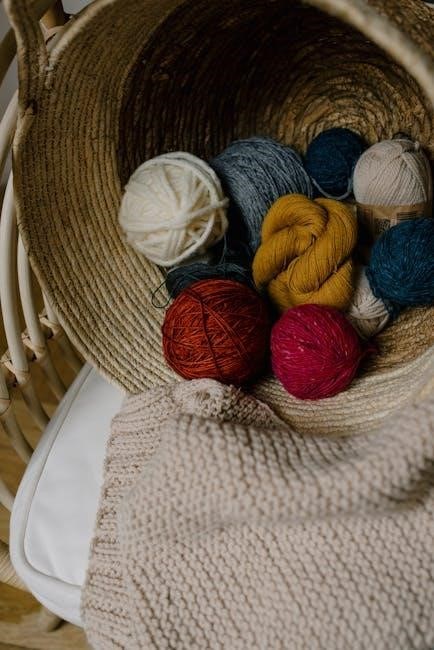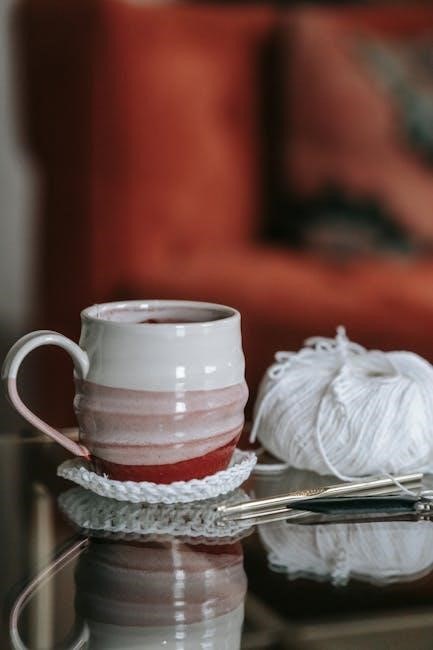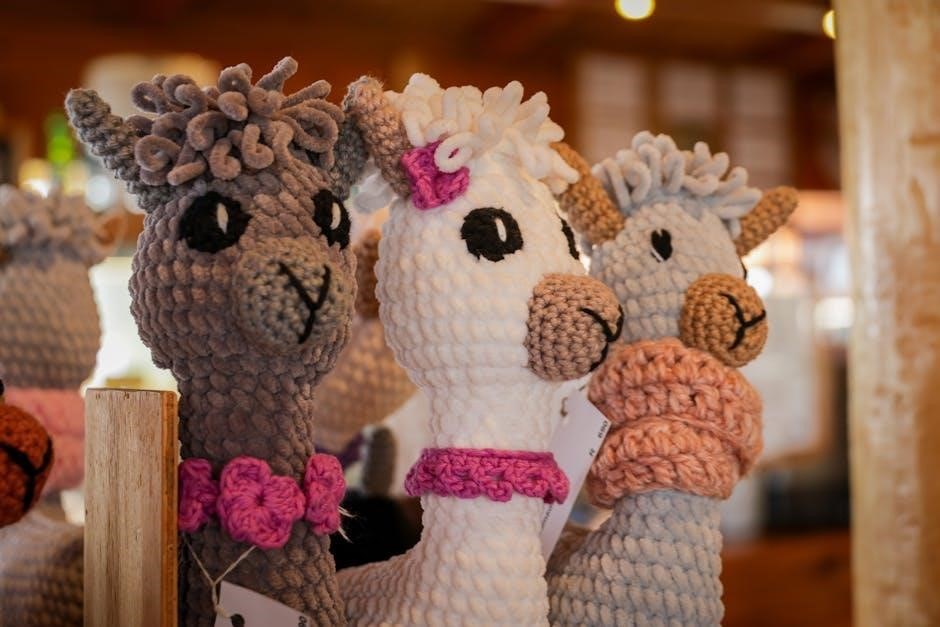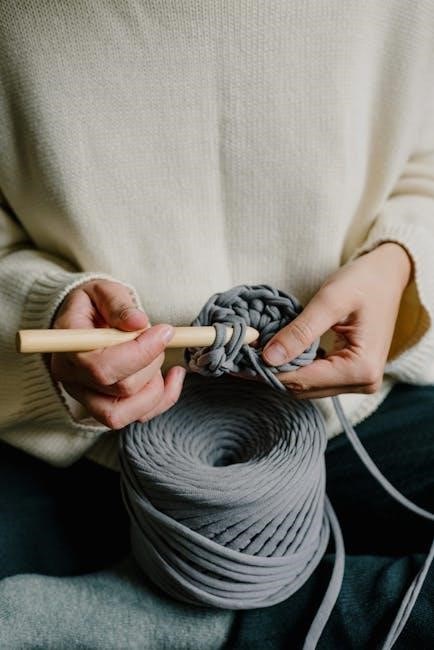Knitting abbreviations are shorthand terms used in patterns to represent common stitches and techniques. They simplify instructions, making patterns concise and easier to follow. Abbreviations like ‘K’ for knit and ‘P’ for purl are universally recognized. Understanding these is essential for interpreting patterns accurately. Many resources, including PDF guides, provide comprehensive lists of knitting abbreviations. These tools help beginners and experienced knitters alike. Abbreviations save space in patterns and streamline the knitting process. They are a fundamental part of knitting terminology, ensuring clarity and efficiency in creating various projects.
1;1 What Are Knitting Abbreviations?
Knitting abbreviations are shorthand terms used to represent common knitting stitches, techniques, and instructions in patterns. These abbreviations are designed to simplify written instructions, making them more concise and easier to follow. They are universally recognized in the knitting community, allowing patterns to be understood across languages and regions. For example, the letter “K” stands for “knit,” and “P” stands for “purl,” which are the most basic stitches in knitting. Other abbreviations, such as “K2tog” (knit two together) and “P2tog” (purl two together), represent common decrease stitches used to shape fabric.
Knitting abbreviations are essential in pattern writing because they save space and reduce redundancy. Instead of writing out full instructions for every stitch or technique, patterns use these shorthand terms to convey the same information more efficiently. This approach is particularly useful in printed or digital knitting patterns, where clarity and brevity are crucial. For instance, a pattern may instruct a knitter to “K to end of row” instead of writing “knit every stitch to the end of the row.” Similarly, “BO” is commonly used to mean “bind off,” a technique used to secure the final row of stitches.
In addition to stitch instructions, knitting abbreviations often include terms for measuring, counting, and shaping. For example, “approx” stands for “approximately,” and “bet” means “between.” These terms help knitters understand where to place markers, increase or decrease stitches, and measure their work. Abbreviations also cover special techniques like cables, lace, and Fair Isle knitting, which involve more complex steps. For example, “C4F” might denote a specific cable pattern, while “m1p” could mean “make one purl stitch.” These abbreviations ensure that patterns remain clear and manageable, even for intricate designs.
Many knitting patterns, especially those available in PDF formats, include a section that defines the abbreviations used. This helps knitters quickly reference unfamiliar terms and ensures that everyone interprets the instructions correctly. Whether you’re a beginner or an experienced knitter, understanding these abbreviations is key to successfully completing a project. They provide a universal language for knitting, allowing patterns to be shared and enjoyed worldwide.
1.2 Importance of Understanding Knitting Abbreviations
Understanding knitting abbreviations is crucial for any knitter, whether they are just starting out or have years of experience. These shorthand terms are the backbone of knitting patterns, allowing designers to communicate complex instructions in a clear and concise manner. Without a solid grasp of these abbreviations, knitters may find themselves confused, leading to mistakes in their work. Misinterpreting even one abbreviation can result in an entire project being ruined, which can be frustrating and time-consuming to fix.

One of the key reasons understanding knitting abbreviations is important is that it ensures accuracy in following patterns. Knitting patterns often involve repetitive instructions, and using abbreviations helps to avoid redundancy. For example, instead of writing “knit one stitch” every time, the abbreviation “K” is used. This not only saves space but also makes the pattern easier to read and follow. When knitters understand these abbreviations, they can work through patterns more efficiently, maintaining the correct tension and stitch count.
Another important aspect is consistency. Knitting abbreviations are standardized, meaning the same abbreviations are used across different patterns and designers. This consistency allows knitters to transition seamlessly between projects without having to learn a new set of terms each time. For instance, “K2tog” always means “knit two stitches together,” regardless of the pattern or designer. This universality ensures that knitters can rely on their knowledge of abbreviations to interpret any pattern they encounter.

Understanding knitting abbreviations also opens up access to a wider range of patterns. Many patterns, especially those in PDF formats, rely heavily on these shorthand terms. Without knowing what the abbreviations stand for, knitters may feel limited to simpler projects or forced to avoid certain techniques altogether. By mastering these abbreviations, knitters can explore more complex and rewarding patterns, such as cables, lace, and Fair Isle knitting, which often involve specialized terms like “C4F” (cable 4 front) or “m1p” (make one purl stitch).
Moreover, knitting abbreviations are essential for learning advanced techniques. Many techniques, such as shaping garments or creating textured fabrics, rely on specific abbreviations to guide the knitter through the process. For example, “PM” (place marker) and “SM” (slip marker) are commonly used to help knitters keep track of their place in a pattern. Without understanding these terms, it becomes difficult to master the techniques they represent, limiting a knitter’s ability to grow and improve their skills.
Finally, understanding knitting abbreviations saves time. Once knitters become familiar with these terms, they can work through patterns more quickly and confidently. Instead of constantly referring to a glossary or tutorial, they can focus on the knitting itself, enjoying the process and seeing their project come to life. This efficiency also reduces frustration, making knitting a more enjoyable and fulfilling hobby.

Common Knitting Abbreviations
Common knitting abbreviations include K (knit), P (purl), K2tog (knit two together), PM (place marker), SM (slip marker), C4F (cable 4 front), and m1p (make one purl stitch). These shorthand terms are essential for clear pattern instructions and accurate stitching. Learning them helps in completing projects efficiently and enjoying the knitting process fully.
2.1 Basic Knitting Terms and Their Abbreviations
Understanding basic knitting terms and their abbreviations is crucial for mastering knitting patterns. Below are some fundamental terms and their commonly used abbreviations:
- K ⎻ Knit: A basic stitch where the yarn is inserted into a stitch and pulled through to create a knit stitch;
- P ⎻ Purl: The opposite of the knit stitch, created by inserting the yarn and pulling it through with the yarn in front of the work.
- K2tog ⎻ Knit Two Together: A decrease stitch where two stitches are knitted as one.
- P2tog ⎻ Purl Two Together: Similar to K2tog but worked on purl stitches.
- CO ‒ Cast On: The process of placing stitches onto the knitting needles to start a project.
- BO ‒ Bind Off: The process of securing the final stitches to complete a project.
- RS ‒ Right Side: The side of the work that will be visible as the right side of the finished garment.
- WS ⎻ Wrong Side: The side of the work that will be hidden as the wrong side of the finished garment.
- Sl ‒ Slip: To move a stitch from one needle to the other without working it.
- Garter ‒ Garter Stitch: A textured stitch pattern created by knitting every row;
- Stockinette ‒ Stockinette Stitch: A smooth stitch pattern created by alternating rows of knit and purl stitches.
- M1 ‒ Make One: An increase stitch where an additional stitch is created.
- KFB ‒ Knit Front and Back: An increase stitch where a single stitch is knitted, then knitted again through the back loop.
- Rep ‒ Repeat: To perform a set of instructions multiple times.
- Rep From * ‒ Repeat From Asterisk: To perform instructions starting from a previously designated point (marked by an asterisk).
- PM ‒ Place Marker: To insert a marker to keep track of a specific position in the pattern.
- SM ‒ Slip Marker: To move a marker from one needle to the other without working it.
- Approx ⎻ Approximately: Used when a measurement or number of stitches is not exact.
- Alt ⎻ Alternate: To alternate between two or more instructions or stitches.
These basic terms and abbreviations form the foundation of knitting patterns. Understanding them allows knitters to interpret instructions accurately and execute stitches confidently. Many of these abbreviations are standardized, ensuring consistency across patterns. For further clarification, knitters often refer to knitting abbreviation guides or PDF resources, which provide detailed explanations and visual aids. By mastering these basics, knitters can tackle a wide variety of projects, from simple scarves to complex garments.
2.2 Stitch Abbreviations (K, P, K2tog, etc.)
Stitch abbreviations are the backbone of knitting patterns, allowing designers to convey complex instructions in a concise manner. These abbreviations represent specific stitches or actions that knitters perform repeatedly in a pattern. Below are some of the most commonly used stitch abbreviations, along with their meanings and usage:
- K ‒ Knit: One of the most basic stitches in knitting, ‘K’ indicates that the knitter should insert the right needle into the first stitch on the left needle and pull up a loop of yarn.
- P ⎻ Purl: The counterpart to the knit stitch, ‘P’ signifies that the knitter should insert the right needle into the first stitch on the left needle and pull up a loop of yarn with the yarn in front of the work.
- K2tog ‒ Knit Two Together: This abbreviation instructs the knitter to decrease by knitting two stitches as one. It is commonly used in patterns to shape garments or reduce stitch count.
- P2tog ⎻ Purl Two Together: Similar to K2tog, but performed on purl stitches. It is used to decrease on the wrong side of the work.
- KFB ‒ Knit Front and Back: An increase stitch where a single stitch is knitted twice—once through the front loop and once through the back loop—resulting in two new stitches.
- M1 ⎻ Make One: An increase stitch where a new stitch is created by picking up a loop between two existing stitches. This is often used to add shaping or symmetry to a project.
- Sl ⎻ Slip: This abbreviation tells the knitter to move a stitch from one needle to the other without working it. It is often used in cable patterns or to hold stitches temporarily.
- C4F ⎻ Cable 4 Front: A specific cable pattern where two stitches are held in front of the work while knitting the next two stitches, then the held stitches are worked. This creates a twisted, rope-like texture.
- Yo ⎻ Yarn Over: An instruction to wrap the yarn around the right needle, creating an intentional hole or space in the fabric. Yarn overs are commonly used in lace patterns.
- Ssk ‒ Slip, Slip, Knit: A decrease worked by slipping two stitches individually and then knitting them together. This creates a smooth, left-leaning decrease.
- K1f&b ‒ Knit One Front and Back: Similar to KFB, this creates an increase by knitting into the front and back of a single stitch.
These stitch abbreviations are essential for interpreting knitting patterns effectively. They allow patterns to be written succinctly while maintaining clarity. Knitters often refer to knitting abbreviation guides or PDF resources to ensure they understand each symbol and its corresponding action; By mastering these abbreviations, knitters can execute stitches with precision and confidence, bringing their projects to life.
2.3 Special Techniques and Their Abbreviations
Special techniques in knitting are essential for creating intricate designs, textures, and shaping in various projects. These techniques often have specific abbreviations that are used in patterns to convey complex instructions succinctly. Understanding these abbreviations is crucial for executing advanced knitting methods effectively.
One of the most common special techniques is cabling, which involves crossing stitches over one another to create a twisted, rope-like texture. Abbreviations like C4F (Cable 4 Front) and C4B (Cable 4 Back) are frequently used. C4F instructs the knitter to slip two stitches onto a cable needle, hold it in front of the work, knit the next two stitches, and then knit the two stitches from the cable needle. Similarly, C4B involves holding the cable needle at the back of the work.
Lace knitting is another popular technique that relies heavily on abbreviations. Yarn overs (Yo) and decreases like Ssk (Slip, Slip, Knit) and K2tog (Knit Two Together) are central to creating the open, airy fabric characteristic of lace. For example, a pattern might instruct the knitter to “Yo, K2tog” to create a basic lace motif. These abbreviations ensure that the pattern remains concise while conveying the precise steps needed to achieve the desired effect.

Shaping techniques, such as raglan sleeves or sweater waistlines, often involve special abbreviations. PM (Place Marker) is used to mark specific points in the knitting, such as the beginning of a raglan sleeve or the start of a buttonhole. SM (Slip Marker) is used when passing a marker from one needle to the other, often in circular knitting or when working in the round. These markers help knitters keep track of their place and ensure symmetry in the finished garment.
Other special techniques include make one (M1) for increasing stitches, pick up and knit (PU&K) for adding stitches along an edge, and bind off (BO) for securing the final row of stitches. These abbreviations are often accompanied by brief instructions or symbols in knitting patterns, particularly in PDF guides, to guide the knitter through the process seamlessly.

Mastering these special techniques and their abbreviations opens up a world of creative possibilities for knitters. Whether it’s intricate cables, delicate lace, or precise shaping, understanding these abbreviations allows knitters to tackle complex patterns with confidence and precision. Knitting abbreviation guides or PDF resources are invaluable tools for deciphering these terms and ensuring that each stitch is executed flawlessly.

Knitting Patterns and Abbreviations
Knitting patterns are detailed instructions that guide knitters in creating specific projects, from simple scarves to complex garments. These patterns rely heavily on abbreviations to convey instructions concisely and efficiently. Understanding knitting abbreviations is essential for interpreting patterns accurately and achieving the desired results. Many knitting patterns are available in PDF formats, which often include comprehensive lists of abbreviations to ensure clarity for knitters of all skill levels.

Knitting patterns typically begin with a list of abbreviations used throughout the document. This list serves as a quick reference guide, allowing knitters to decipher the shorthand terms without interrupting their workflow. Common abbreviations like K (knit), P (purl), K2tog (knit two together), and P2tog (purl two together) are frequently used to describe basic stitches and decreases. These abbreviations ensure that patterns remain uncluttered while still providing all the necessary information.
Beyond basic stitches, knitting patterns often include abbreviations for special techniques, such as cables, lace, and shaping. For example, C4F (Cable 4 Front) and Yo (Yarn Over) are commonly used in patterns to indicate specific actions. These abbreviations are particularly useful in complex patterns, where detailed step-by-step instructions would otherwise make the pattern overly lengthy and difficult to follow. By using standardized abbreviations, designers can create patterns that are both comprehensive and easy to understand.
Many knitting patterns, especially those in PDF format, also include visual aids like charts or diagrams to complement the written instructions. These visuals often use symbols to represent abbreviations, further simplifying the process for knitters. For instance, a cable stitch might be represented by a specific symbol, eliminating the need for lengthy written explanations. This combination of text, abbreviations, and visuals ensures that knitters can follow along with ease, regardless of their experience level.
Knitting patterns and abbreviations go hand in hand, enabling the creation of beautiful and intricate designs. Whether it’s a simple hat or a complex lace shawl, understanding the abbreviations used in patterns is the key to successful knitting. PDF guides and pattern books often provide detailed explanations of these abbreviations, making them accessible to everyone. By mastering knitting abbreviations, knitters can unlock a world of creative possibilities and enjoy the rewarding process of bringing their projects to life.